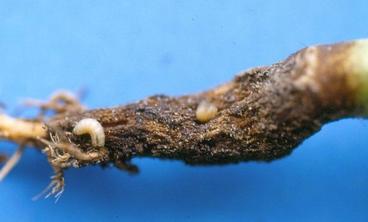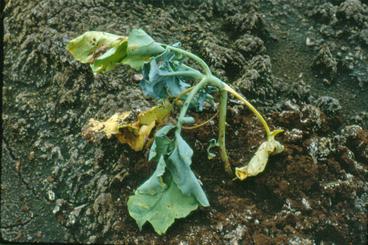K. Van Wychen Bennett, E. C. Burkness and W. D. Hutchison
Department of Entomology, University of Minnesota
Introduction

The cabbage maggot, Delia radicum, is a sporadic pest of many cole crops including cabbage, broccoli, cauliflower, Brussels sprouts, turnips, radishes, kale, and other crops of the mustard family. Occasionally, they will attack other vegetables such as beets and celery. The cabbage maggot, both in the adult and larval stages, looks similar to the seed corn maggot, Delia platura. However, the cabbage maggot usually prefers to feed on the roots of cole crops whereas the seed corn maggot prefers the seeds and seedlings of beans, corn, and cucurbits. Under the right conditions, however, seed corn maggots may also attack the seeds of cole crops.
Biology & Life Cycle
The cabbage maggot is an exotic pest from Europe that has been in the United States since the early 1800's. Although the cabbage maggot spread throughout most of North America, it causes more damage among cole crops in the northern United States and Canada. The insect prefers wet, cool conditions. The cabbage maggot overwinters in small, brown egg-shaped pupariums about 1 to 5 inches below the soil surface. In early spring, the adults emerge. The adults fly close to the ground and lay eggs in cracks near plants or on the plant where the plant meets the soil surface. The eggs hatch 3 to 7 days later. Cabbage maggots look like seedcorn maggots and are legless, yellowish-white, and achieve a maximum size of about ¼ inch in length. Generally, the two species can only be distinguished under a microscope. When cabbage maggots emerge, they immediately start feeding on the roots of the host plant. They feed on the roots 3 to 4 weeks before pupating in the soil. Cabbage maggot adults also look similar to the seed corn maggots but are slightly larger. The adults, about ½ the size of a small housefly, are dark gray with black stripes on their backs and black bristles cover their bodies.
Damage

Seedlings and transplants are more susceptible to cabbage maggots during a wet, cold spring with most of the damage limited to the early spring plantings. Injury from the second generation in late June or July is usually not severe because the maggots prefer cool, moist conditions and younger, more tender plants. A third generation, however, may damage any cole crops planted later in the growing season. Maggots feed on the root hairs and can create extensive, slimy tunnels on the root surface and throughout the roots. Maggot feeding on the roots can cause the plants to look sickly, small, or off-color. Depending on the number of maggots invading the roots, plant death can result. Moreover, feeding damage may allow fungal pathogens to enter the root. However, the damage caused by the cabbage maggots is sometimes difficult to distinguish from other problems. For example, off-color symptoms sometimes indicate nutrient problems.
Management Options
Once cabbage maggot damage is noticed, it is too late to apply control procedures. Thus, economic thresholds are not useful and all management options are preventative.
Monitoring
Since the first generation of cabbage maggots is the most damaging, planting seeds or transplants after the peak of adult emergence and egg laying in the spring may provide the best control. Growers may monitor cabbage maggot population fluctuations using the following procedure:
- To use this procedure, correct identification of cabbage maggot adults is crucial.
- In early May, place yellow pails filled with soapy water along the field edges at intervals of 100 feet. Many insects are attracted to yellow and are trapped when they fall into the water.
- Empty pails every 4 to 6 days and refill with soapy water.
- Keep records of the captured cabbage maggot flies; these records should indicate whether populations are increasing or decreasing.
In addition, you can estimate peak emergence of adult flies on the VegEdge Degree-day page. To calculate degree days on your own, use the following formula starting on April 1.
- (Max. temperature + min. ambient temperature/2) - 43 F
- Peak emergence of the first three generations will occur when 300, 1475, and 2650 degree-days have accumulated, respectively.
Chemical Control
The available chemical options are preventative; no insecticides are labeled for use once an outbreak is underway. Chemical control consists of soil drenches at transplanting. Applying soil insecticides, however, may harm natural enemies of maggots such as beetles and other ground insects that prey upon maggot eggs (see below). To ensure proper use of insecticides, refer to the most recent edition of the Midwest Vegetable Production Guide (BU-7094-S).
Cultural Control
Adult cabbage maggot flies are probably attracted to rotting organic matter and freshly plowed fields. Avoid plowing fresh animal manure, weeds, green manure, or other cover crops in spring. If there is a winter cover crop, plow it at least 3-4 weeks before planting. Plowing crops in fall is better than plowing crops in spring because the cabbage maggot flies are more attracted to live, green organic matter incorporated into the soil. If cole crops are directly seeded, use a drag chain behind the planter to eliminate any moisture differences in the soil between the seed row and the adjacent soil. Moisture from newly planted seed rows can attract cabbage maggots.
Biological Control
Naturally occurring soil-inhabiting fungi may attack and decrease cabbage maggot larval populations. Predaceous ground beetles also eat cabbage maggot eggs, larvae, and pupae. Parasitic wasps also help to reduce cabbage maggot population. At the present time, there are no commercially available biological control options.
References
Cornell University. 2003. Vegetable Disease ID and Management http://vegetablemdonline.ppath.cornell.edu/
Foster, R. & B. Flood. 1995. Vegetable Insect Management. Meister Publishing Co. Willoughby, Ohio.
Metcalf, R.L. & R.A. Metcalf. 1993. Destructive and Useful Insects. 5th Edition. Insects Injurious to Cucurbits. McGraw-Hill, Inc. New York.
University of Minnesota Extension Service BU-7094-S. Midwest Vegetable Production Guide for Commercial Growers: https://ag.purdue.edu/btny/midwest-vegetable-guide/Pages/default.aspx
Vegetable Crop Scouting Manual. Integrated Pest Management Program-University of Wisconsin Extension, Cooperative Extension Service. Madison, WI, 1998.